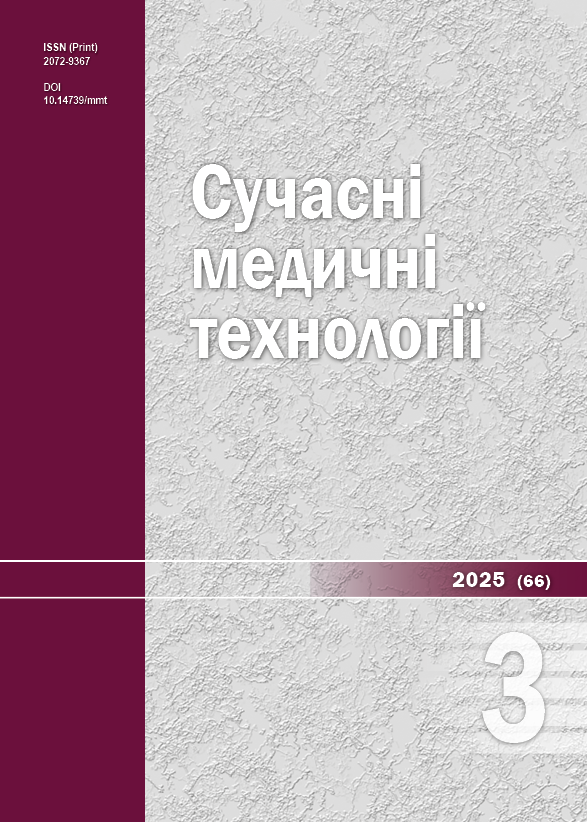Assessment of occupational risks from exposure to suspended ultrafine particles of industrial aerosol for workers of a metallurgical enterprise
DOI:
https://doi.org/10.14739/mmt.2025.3.332108Keywords:
metallurgical production, ultrafine industrial aerosol, carcinogenic risk, non-carcinogenic riskAbstract
Aim. To assess occupational risks from exposure to suspended ultrafine particles of industrial aerosol for workers of a metallurgical enterprise.
Materials and methods. The study of the content of suspended particles was carried out at the workplaces of metallurgical production workers using a portable scanning spectrometer Nanoscan 3910 (USA). Their chemical composition was studied by optical emission spectrometry with inductively coupled plasma (OES-ICP) on the device “Optima 2100 DV” manufactured by “PerkinElmer” (USA). Based on the results obtained, carcinogenic and non-carcinogenic risks were calculated.
Results. It was established, that in the air of the working area of the open-hearth furnace steelworker, the total numerical concentration of suspended particles was 6.9 × 104 (4.0 × 104; 8.0 × 104) particles/cm3, in the air of the working area of the blast furnace – 5.1 × 104 (4.5 × 104; 7.8 × 104), in the air of the sinter plant working area – 2.4 × 104 (2.1 × 104; 5.1 × 104). All indicators exceeded the total numerical concentration of suspended particles of control workers and were statistically significantly higher (p ˂ 0.001). The composition of suspended particles included Si, Al, P, Fe, Ca, Mg, Cr and Ni, which is due to the type of technological process. Exceedances of hygienic standards was observed for P, Cr and Ni. The calculated carcinogenic risk indicators for workers from exposure to chromium and nickel were high. The hazard coefficients from exposure to suspended particles with element densities >6 kg/m3 and <6 kg/m3 for an open-hearth furnace steelworker were HQ = 3.15 and HQ = 1.57, for a blast furnace worker – HQ = 2.54 and HQ = 1.27, for a sinter plant worker – HQ = 3.15 and HQ = 1.57, respectively. The greatest non-carcinogenic risk was caused by particles up to 64 nm in size. The risk excess factor at the workplace of an open-hearth furnace steelworker, compared with workers in the control group, was 224.8 times, at the workplace of a blast furnace worker – 61.9 times, and at the workplace of a sinter plant worker – 12.9 times.
Conclusions. During the production of sinter, cast iron and steel, suspended particles of combined chemical composition are formed at the workplaces of workers. The obtained carcinogenic risk values from exposure to chromium and nickel for all workers were high. The hazard coefficients from exposure to suspended particles for almost all workers exceeded unit, that can be considered unacceptable. The greatest risk, depending on the size, for all workers was posed by the smallest particles (≤64 nm).
References
Belokon KV, Troicka OO, Ryzhkov VG. [Analysis of harmful and dangerous productive factors of electrometallurgy production]. Collection of scholarly papers of Dniprovsk State Technical University (Technical Sciences). 2019;(1):150-6. Ukrainian. doi: https://doi.org/10.31319/2519-2884.34.2019.29
Prodanchuk MH, Basanets AV, Kravchuk OP, Hashynova KY, Hvozdetskyy VA. [Analysis of the dynamics of occupational morbidity and its consequences in Ukraine in comparison with other countries of the world]. Medicni perspektivi. 2023;28(3):137-52. Ukrainian. doi: https://doi.org/10.26641/2307-0404.2023.3.289217
Pavlenko OI. [Determination of the permissible period of work in the conditions of modern metallurgical production]. Coliection of scientific works of staff member of PL Shupyk NMAPE. 2018;(29):380-92. Ukrainian. Available from: http://nbuv.gov.ua/UJRN/Znpsnmapo_2018_29_37
Sharavara LP, Dmytrukha NM. [Working conditions as a risk factor for the health of employees of a metallurgical enterprise]. Bulletin of problems biology and medicine. 2024;1:126-38. Ukrainian. doi: https://doi.org/10.29254/2077-4214-2024-1-172-126-1374
Oriekhova OV. Suchasnyi stan umov pratsi v metalurhiinomu vyrobnytstvi Ukrainy [The current state of working conditions at metallurgical enterprises of Ukraine]. ScienceRise. Medical science. 2016;(10):34-39. Ukrainian. doi: https://doi.org/10.15587/2519-4798.2016.79865
Sharavara LP, Dmytrukha NM, Andrusyshyna IM. Ultrafine industrial aerosol as an occupational risk factor for sintering industry workers. Modern medical technology. 2024;16(4):303-9. doi: https://doi.org/10.14739/mmt.2024.4.311754
Marcias G, Fostinelli J, Catalani S, Uras M, Sanna AM, Avataneo G, et al. Composition of Metallic Elements and Size Distribution of Fine and Ultrafine Particles in a Steelmaking Factory. Int J Environ Res Public Health. 2018;15(6):1192. doi: https://doi.org/10.3390/ijerph15061192
Calderón-Garcidueñas L, Ayala A. Air Pollution, Ultrafine Particles, and Your Brain: Are Combustion Nanoparticle Emissions and Engineered Nanoparticles Causing Preventable Fatal Neurodegenerative Diseases and Common Neuropsychiatric Outcomes? Environ Sci Technol. 2022;56(11):6847-56. doi: https://doi.org/10.1021/acs.est.1c04706
Liu NM, Miyashita L, Maher BA, McPhail G, Jones CJ, Barratt B, et al. Evidence for the presence of air pollution nanoparticles in placental tissue cells. Sci Total Environ. 2021;751:142235. doi: https://doi.org/10.1016/j.scitotenv.2020.142235
Pryor JT, Cowley LO, Simonds SE. The Physiological Effects of Air Pollution: Particulate Matter, Physiology and Disease. Front Public Health. 2022;10:882569. doi: https://doi.org/10.3389/fpubh.2022.882569
Ministry of Health of Ukraine. [On approval of state medical and sanitary standards for the permissible content of chemical and biological substances in the air of the working area zone]. Order dated 2024 Jul 9, No. 1192 [Internet]. 2025 Apr 11 [cited 2025 May 26]. Ukrainian. Available from: https://zakon.rada.gov.ua/laws/show/z1107-24#Text
Ministry of Health of Ukraine. [Methodological recommendations "Assessment of risks to workers' health from air pollution in the work area with chemicals"]. Order dated 2024 Mar 2, No. 358 [Internet]. 2024 [cited 2025 May 26]. Ukrainian. Available from: https://zakon.rada.gov.ua/rada/show/v0358282-24#Text
Järvelä M, Huvinen M, Viitanen AK, Kanerva T, Vanhala E, Uitti J, et al. Characterization of particle exposure in ferrochromium and stainless steel production. J Occup Environ Hyg. 2016;13(7):558-68. doi: https://doi.org/10.1080/15459624.2016.1159687
Jan R, Roy R, Yadav S, Satsangi PG. Chemical fractionation and health risk assessment of particulate matter-bound metals in Pune, India. Environ Geochem Health. 2018 Feb;40(1):255-70. doi: https://doi.org/10.1007/s10653-016-9900-7
Jena S, Perwez A, Singh G. Trace element characterization of fine particulate matter and assessment of associated health risk in mining area, transportation routes and institutional area of Dhanbad, India. Environ Geochem Health. 2019;41(6):2731-47. doi: https://doi.org/10.1007/s10653-019-00329-z
Esmaeili R, Ebrahimpour K, Esmaeili SV, Karimi A, Kamranifar M, Pour MN, et al. Chemical health risk assessment of exposure to metal fumes among employed workers in a metal manufactory with an electric arc furnace. Int J Environ Health Eng. 2024;13(1):18. doi: https://doi.org/10.4103/ijehe.ijehe_52_23
Macko M, Antoš J, Božek F, Konečný J, Huzlík J, Hegrová J, Kuřitka I. Development of New Health Risk Assessment of Nanoparticles: EPA Health Risk Assessment Revised. Nanomaterials (Basel). 2022;13(1):20. doi: https://doi.org/10.3390/nano13010020
Downloads
Additional Files
Published
How to Cite
Issue
Section
License
Copyright (c) 2025 L. P. Sharavara, N. M. Dmytrukha, I. M. Andrusyshyna

This work is licensed under a Creative Commons Attribution-NonCommercial 4.0 International License.
The work is provided under the terms of the Public Offer and of Creative Commons Attribution-NonCommercial 4.0 International (CC BY-NC 4.0). This license allows an unlimited number of persons to reproduce and share the Licensed Material in all media and formats. Any use of the Licensed Material shall contain an identification of its Creator(s) and must be for non-commercial purposes only.














